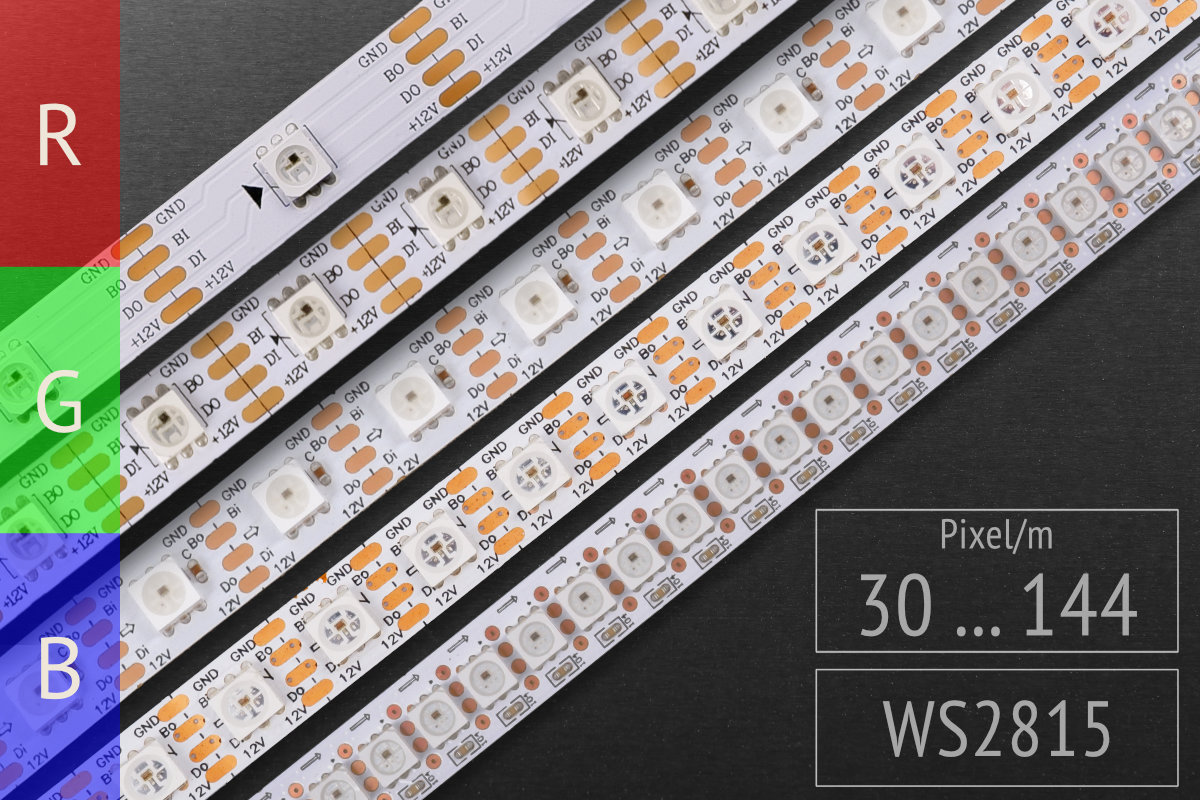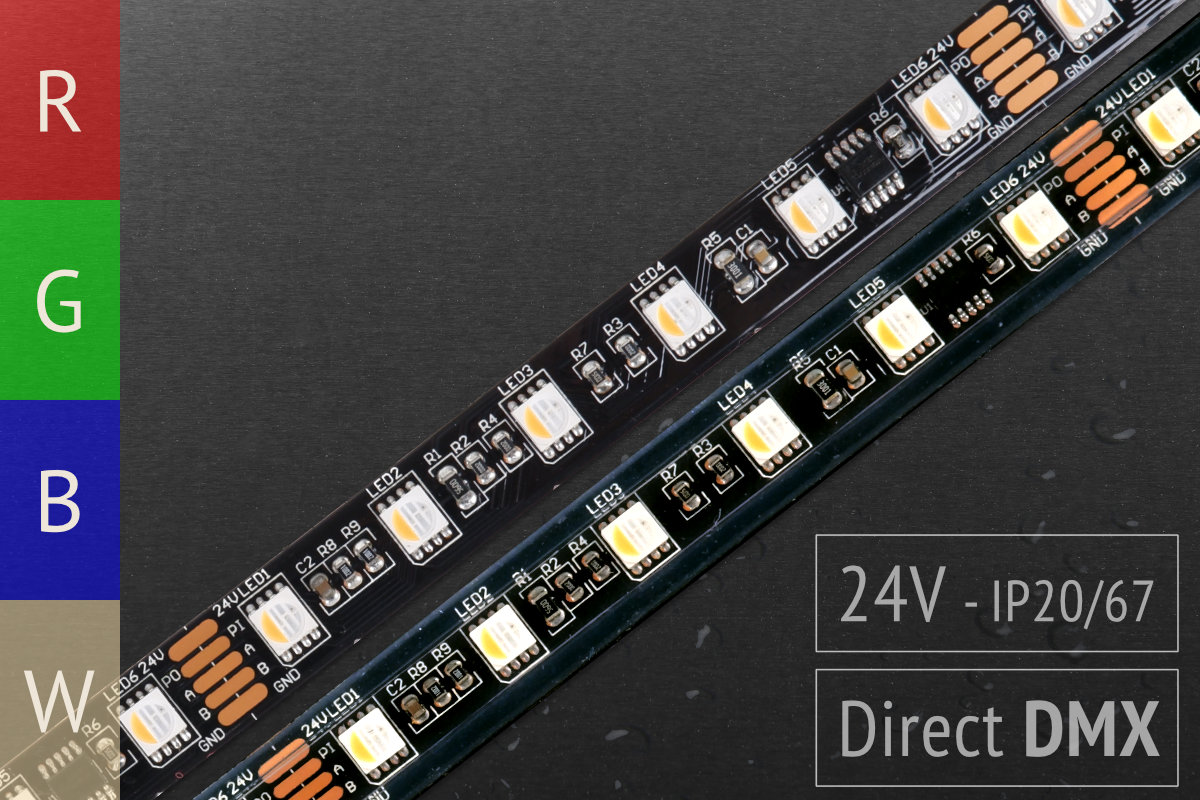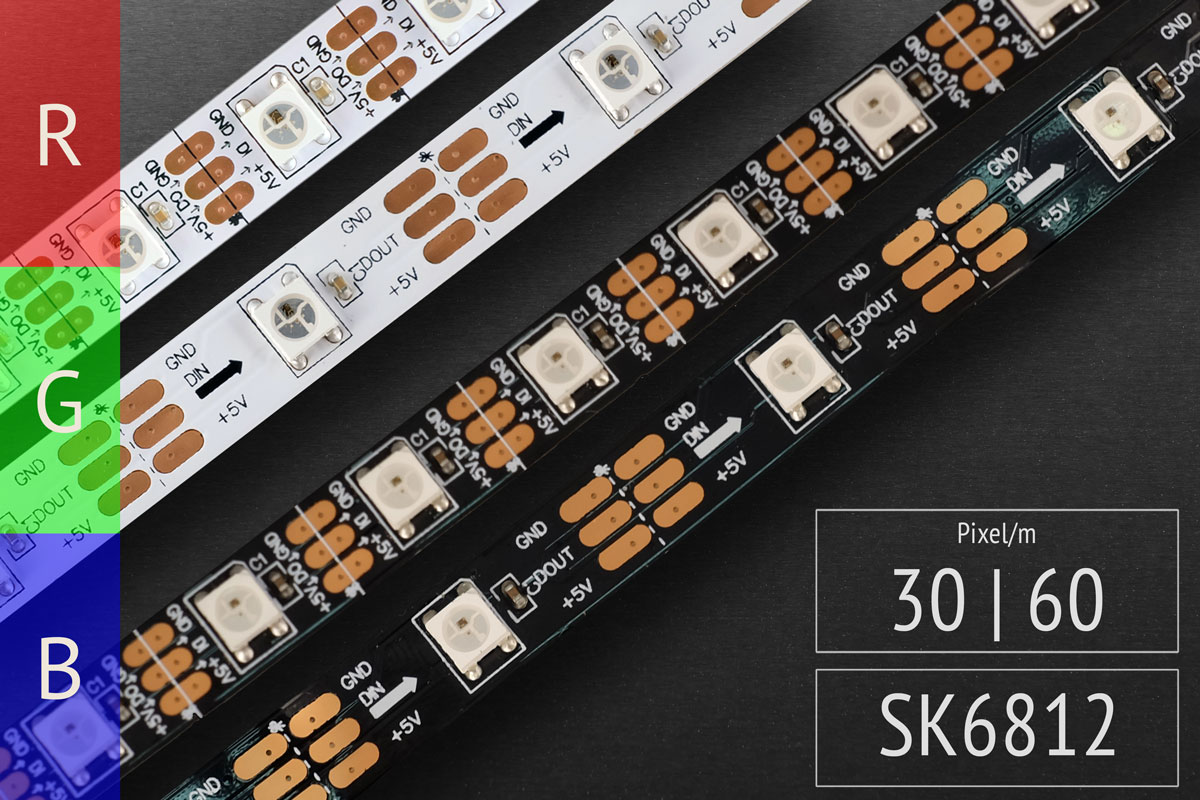Filter products
Pixel Strips
Pixel LED strips with individually controllable LEDs we offer in various designs and with various control ICs, e.g.:
- WS2801
- WS2812B (with WS2811 IC)
- WS2815 with 12V DC
- SK6812 in RGB, RGBW and pure white
- APA102c
- Direct DMX
A more detailed comparison of the individual LED pixel variants can be found below.
Most digital LED strips are available in 30 and 60 pixels/m versions. In addition, many LED strips are available in white or black. Just ask us!
Pixel driver for controlling the digital LEDs we offer in a separate category.
Content: 5 Meter (€9.80* / 1 Meter)
Content: 5 Meter (€37.00* / 1 Meter)
Content: 5 Meter (€25.00* / 1 Meter)
Content: 5 Meter (€4.90* / 1 Meter)
previously €49.00*
Content: 5 Meter (€25.00* / 1 Meter)
Content: 4 Meter (€10.00* / 1 Meter)
previously €80.00*
Content: 5 Meter (€9.00* / 1 Meter)
Content: 5 Meter (€11.80* / 1 Meter)
Content: 4 Meter (€15.00* / 1 Meter)
Content: 5 Meter (€16.00* / 1 Meter)
Content: 5 Meter (€8.50* / 1 Meter)
previously €85.00*
Content: 5 Meter (€13.00* / 1 Meter)
Content: 5 Meter (€2.94* / 1 Meter)
previously €49.00*
Pixel types
Currently we offer digital LED strips with 5 different pixel types. Each of them has its specific advantages and disadvantages, so it is necessary to choose the right one depending on the project.
WS2801
WS2801 is a classic LED pixel driver that has a total of 4 connections: + | - | DATA | CLOCK.
The separate CLOCK line allows precise timing at high data rates and a high PWM frequency of 2.5kHz. WS2801 are therefore especially useful where fast animations and flicker-free operation (especially in camera shots) are required. Due to the separate CLOCK line, WS2801 can also be operated directly on an SPI, e.g. also directly on a Raspberry Pi. A disadvantage of WS2801 is the comparatively large IC, which sits separately on each LED strip. This means that e.g. narrow LED spacing is not possible (cf. 32 pixels/m). With a pixel count >500 it makes sense to use repeater boards.
- separate CLOCK line (ges. 4 connections)
- therefore exact timing and high PWM frequency of 2.5kHz
- can be operated directly on a SPI
- color depth: 8bit
APA102c
The APA102 - also called "SuperLED" - can be considered as the successor of the WS2801. Here, too, there are 4 connections: + | - | DATA | CLOCK.
With the separate CLOCK line, very precise timing at high data rates is also possible here and can even realize extremely high PWM frequencies up to 20kHz. In contrast to the WS2801, the pixel driver of an APA102 LED is tiny and directly integrated in the LED. This allows for tighter LED densities (e.g. 60 pixels/m). As a special feature, a Global Brightness can be set for APA102, which reduces the brightness of all 3 RGB colors evenly. However, since the Global Brightness only works with 580Hz PWM, it is better to do without this function.
- separate CLOCK line (ges. 4 connections)
- therefore exact timing and extremely high PWM frequency up to 20kHz
- can be operated directly at a SPI
- color depth: 8bit
WS2812 / WS2812B
The WS2812 and the improved version WS2812B are currently the most widely used LED pixels. They have a comparatively simple design and only need 3 lines: + | - | DATA
The timing of the WS2812 is therefore generally more critical and no such high data rates can be achieved. PWM frequencies are only possible up to 430Hz. Camera shots of the LED pixels would immediately show strong flickering. WS2812 and WS2812B can also not be operated directly on a SPI, such as Raspberry Pi. Since WS2812 are very susceptible to voltage spikes, a protection board should always be used here in front of the digital LED strips. Like the APA102, the WS2812 pixel's driver IC (WS2811) is tiny and built directly into the LED. This allows higher pixel densities up to 60 pixels/m.
- only 3 lines, no CLOCK signal
- therefore more difficult timing and low PWM frequency of only 430Hz
- color depth: 8bit
- very favorable
The LED type WS2812B has in contrast to the older WS2812 only 4 instead of 6 connection pins, as well as some detail improvements. It has a better thermal management and is protected against reverse polarity of the power supply.
SK6812
The SK6812 is a successor of the widely used WS2812. Also this LED pixel work only with 3 lines: + | - | DATA
Compared to WS2812 the SK6812 has some advantages. It is less critical for timing inaccuracies and so the SK6812 reaches up to 1.100Hz PWM. In addition to the typical RGB variants, the SK6812 also has RGBW pixels that offer an additional white LED. Pure white pixel strips are also available. The SK6812 is much more robust against voltage peaks. In general no protection board is needed.
- only 3 lines, no CLOCK signal
- improved timing tolerance, PWM up to 1.100Hz
- color depth: 8bit
- RGBW available
WS2815
WS2815 LEDs are a further development of the popular WS2812 and therefore compatible with all controllers that can control WS2812. However, WS2815 offer some advantages. Instead of only 5V, WS2815s are powered with 12V, which greatly simplifies cabling, especially for larger installations (>2m). Even 5m in one piece can be realized with only one voltage supply.
Furthermore WS2815 have a double led data line (therefore also 4 solder contacts and not only 3). This ensures that if one pixel fails, all other pixels remain unaffected and continue to light up. In addition, a very fast 2,000Hz PWM is used.
- Double-routed data line for increased fail-safety
- 12V supply voltage significantly simplifies cabling
- 2,000Hz PWM
Direct DMX
DMX is the standard control protocol in the lighting industry. All theaters, TV studios and event organizers rely on DMX. Digital LED strips with Direct DMX pixels can be controlled directly via the DMX signal. This saves intermediate converters, which convert e.g. DMX first into a WS2812 signal. Direct DMX strips are available in versions with 12 or 24 volts, where several LEDs are connected to a "pixel". This makes it easier to realize longer distances without having to permanently re-supply the voltage.
What pixel density do I need?
For pixel strips / running lights, the required pixel density depends on the speed of the planned running light animation. Higher pixel densities are needed for slower animations, otherwise the animation will jump from one pixel to the next. A good rule of thumb is 20 divided by the planned chaser speed in m/s. If the chaser is not to be animated slower than 1m/s, 20/1 = 20 pixels/m will suffice as pixel density.
However, this rule of thumb only applies to very hard animations without transitions, e.g. when one pixel is 100% red and the next pixel is 100% green. If the animation works with transitions, i.e. in the example with a smooth change from red to green within a pixel, much lower pixel densities or much higher speeds are possible. The otherwise very hard jump from one color to another is then blended smoothly and is no longer noticeable. Often even 10 pixels/m are enough.
So it always depends on the animation. Also keep in mind that depending on the size of the structure and the distance of the viewer, even speeds of 1m/s can look very slow.









